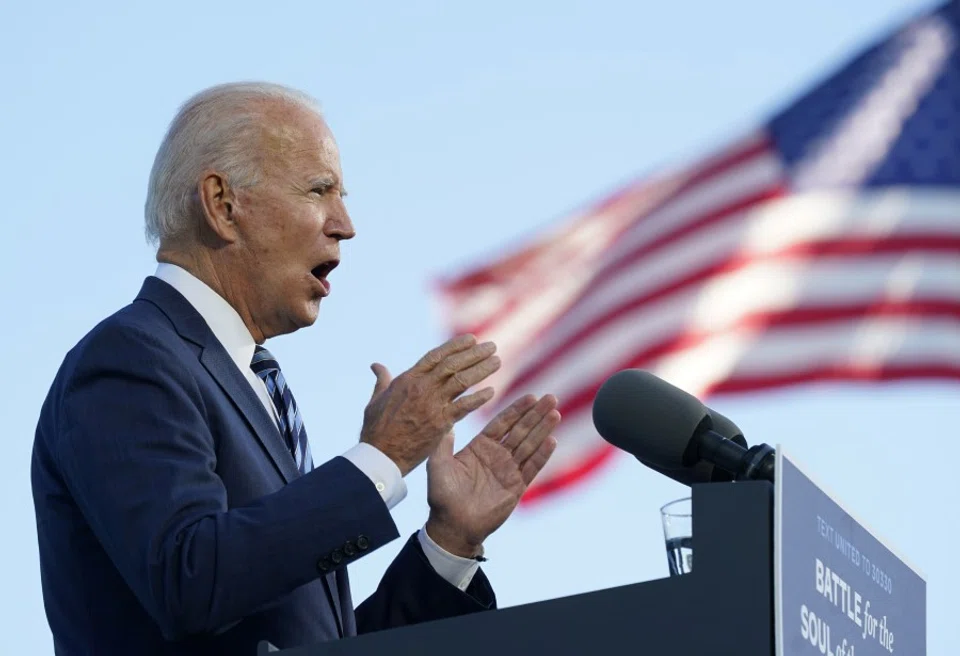How a Biden presidency can win back lost American influence in Southeast Asia
If elected the president of the US, Joe Biden will not necessarily gain traction in Southeast Asia by simply not being Trump. He will have to bring tangible economic and political options to the table, and harness the intrinsic power of America's network of allies and partners.

Since taking office, US President Donald Trump has repeatedly claimed to have restored America's place in the world. As he put it on 6 February: "Our country is respected again - by everybody."
Most Southeast Asians would disagree. Polls conducted by institutions like the ISEAS - Yusof Ishak Institute and Center for Strategic and International Studies show that the region has, in fact, lost confidence in the US as the Trump era has dragged on. In February 2020, former Malaysian Prime Minister Mahathir Mohamad even asked Trump "to resign to save America", a comment that indicates anything but respect. "Americans are nice people", he added. "But not President Trump."
Mahathir's comments are more reflective of reality than Trump's. Indeed, Trump has weakened the US position in Southeast Asia by pulling out of the Trans-Pacific Partnership (TPP), pursuing punitive economic measures against countries in the region, skipping multiple ASEAN summits, berating regional leaders over strategically-irrelevant issues like deportations to the region, and alienating many with his anti-Muslim rhetoric. While Trump has left empty ambassadorships to Myanmar, Singapore and ASEAN, his administration has implied that Southeast Asians should not only stand up to China but also choose between the US and China - a binary choice that leaders from Hanoi to Singapore to Jakarta reject. In a region where showing up is half the battle won, Trump has been both chronically absent and unnecessarily aggressive on issues like trade.
Biden would need to engage Southeast Asians by listening to their concerns, rather than considering them only as mere appendages of the US in the broader battle against China, and offer tangible economic benefits to the region.

If elected president, former Vice President Joe Biden could arguably rectify many of these flaws simply by not being Trump. But this likely will not be enough to win back lost American influence in Southeast Asia. To do so, Biden must maintain a hard line on China while walking back Trump's Cold War-like conception of rival blocs between the US and China. Biden would need to engage Southeast Asians by listening to their concerns, rather than considering them only as mere appendages of the US in the broader battle against China, and offer tangible economic benefits to the region. After Trump, vague promises and friendly rhetoric will not be enough.
By implication at least, the White House's Free and Open Indo-Pacific Strategy poses a direct choice between the "free" American and "repressive" Chinese visions of world order. Still, Southeast Asians are neither interested nor able to jettison relations with China in favour of those with the US. Even formal US military allies like Thailand and the Philippines have close ties with China, which they will not soon give up. Singaporean Prime Minister Lee Hsien Loong has repeatedly made clear that Southeast Asians do not want to be forced to choose between the US and China.
Biden, therefore, must avoid casting the Sino-American rivalry in stark Cold War-era binaries, but stick to the path that he has already followed: leveraging the "strongest powerful network" of US allies and partners to fight global threats and uphold the international liberal order. Biden must also deepen, reform and expand American engagement with the region, even while many countries continue cooperating with China.
Biden, therefore, would be wise to spearhead a new era of multilateralism by coordinating with allies like Australia and Japan and developing a compelling multilateral investment alternative to China's Belt and Road Initiative (BRI).
This engagement should comprise comprehensive economic, rather than just strategic and military, benefits. Trump's backing of Southeast Asian countries in the South China Sea and Mekong River, like George W. Bush and Obama's support for counterterrorism in the region, is necessary and welcome, but these efforts are not enough to secure American regional interests.
Southeast Asian leaders appreciate but need more than military and political backing. They need investment and aid - and, perhaps above all, to believe that the US is paying attention and will not execute a strategic retrenchment from the region.

Biden, therefore, would be wise to spearhead a new era of multilateralism by coordinating with allies like Australia and Japan and developing a compelling multilateral investment alternative to China's Belt and Road Initiative (BRI). Such an alternative must come complete with environmental and transparency mechanisms, also promising to employ local rather than imported workers - fronts on which the BRI, a development programme designed for China's benefit, fails. Such a bold scheme will both serve American economic interests and address a real need in the region - the need for capital to build regional infrastructure. With such a multilateral programme, Washington could indirectly yet effectively challenge the BRI from a position of strength, instead of haphazardly trying to do so with bilateral agreements.
It is vital that the US changes the reality on the ground, in which Southeast Asians "have to go to the Chinese" for infrastructure investment "whether we like it or not", as Mahathir puts it. This state of affairs is not one in which the US can hope to compete.
Washington can and should work more closely with Japan on building regional infrastructure solutions, given that the latter has already gained much traction in Southeast Asia as an alternative to China in funding such projects.

The US, Japan and Australia have already taken solid initial steps towards addressing the issue. In November 2019, the trio announced the Blue Dot Network, which seeks to certify infrastructure projects around the world that meet high transparency, sustainability and developmental standards. Washington can and should work more closely with Japan on building regional infrastructure solutions, given that the latter has already gained much traction in Southeast Asia as an alternative to China in funding such projects. Between 2008 and 2016, Japan doled out US$36.9 billion in infrastructure financing to the region. This was only a tad lower than China's US$42.3 billion. In contrast, though, the US provided a paltry US$1.1 billion.
Overall, a Biden re-pivot to Asia cannot be Obama 2.0. There should be no optimistic liberalism; instead Biden's liberalism should be steely-eyed, harbouring no expectation that Southeast Asians will choose the US simply because American values are superior to those of China.
Instead, Biden must go to bat for the US and convince Southeast Asians in practical terms - economic, strategic and political - why American regional leadership benefits them, rather than just focusing on how China's alternative does not. The US must go beyond the rhetoric of getting Southeast Asian states to "choose" Washington instead of Beijing; the Americans must bring something tangible to the table.
This article was first published as ISEAS Commentary 2020/151 "Biden "Re-pivot" to Asia Cannot Be Obama 2.0" by Charles Dunst.



![[Photos] Fact versus fiction: The portrayal of WWII anti-Japanese martyrs in Taiwan](https://cassette.sphdigital.com.sg/image/thinkchina/3494f8bd481870f7c65b881fd21a3fd733f573f23232376e39c532a2c7593cbc)

